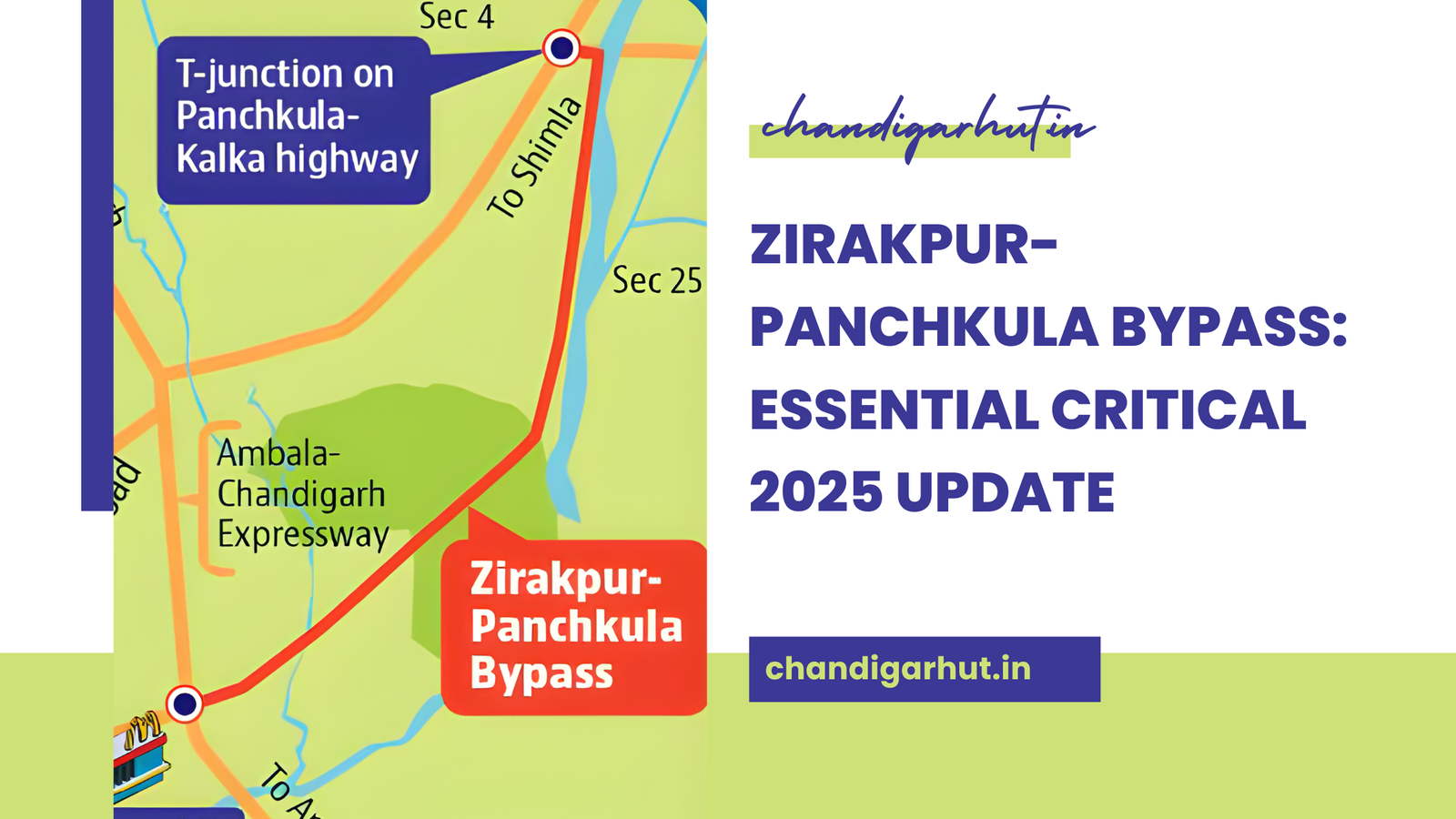Zirakpur-Panchkula Bypass remains one of the most anticipated infrastructure projects in the Tricity. The project has drawn attention for the repeated delays even six months after in-principle approval from the Cabinet Committee on Economic Affairs, chaired by Prime Minister Narendra Modi.
Background and Purpose of the Zirakpur-Panchkula Bypass
The Zirakpur-Panchkula Bypass is designed to relieve traffic on NH-5 and NH-7 by diverting through-traffic away from Zirakpur and Panchkula into a dedicated six-lane corridor. The 19.2 km route runs from the Zirakpur-Patiala junction on NH-7 to the Zirakpur-Parwanoo junction on NH-5, and includes a 6.195 km elevated section, five flyovers, one vehicular underpass, nine light vehicular underpasses, one major bridge, one minor bridge and a railway overbridge. This ambitious corridor is envisioned as a cornerstone of the Tricity ring road network and a key link for traffic headed toward Himachal Pradesh.
As part of the PM Gati Shakti National Master Plan, the project is being executed under the hybrid annuity mode HAM. The scheme aims to blend public funding with private investment, providing a clearer path to delivery while distributing risk. Once complete, the bypass is expected to significantly reduce congestion on the Chandigarh International Airport corridor and the busy Zirakpur-Chandigarh route, improving overall travel times for residents and visitors alike.
Status Update: Cabinet Nod, Forest Clearance and Bidding Delays
Even after the Cabinet Committee on Economic Affairs accorded in-principle approval, the project remains on paper and has faced repeated delays. The National Highways Authority of India (NHAI) Punjab division has extended the last date for online bids to 11 am on November 20, with technical bids opening on November 21. The extension comes amid delays in Stage-2 forest clearance, where the proposal to divert 17.57 hectares of forest land is under process and verification is pending with the Forest Department.
Stage-1 clearance granted in August allowed forest land diversion for non-forestry use subject to strict conditions, including compensatory afforestation, payment of net present value, no change in land use, and ensuring that no damage is caused to adjoining forest areas or wildlife. Final Stage-2 approval will be issued only after compliance verification. Officials note that work could not be awarded until final forest clearance is obtained, underscoring how forest administration steps remain a critical bottleneck.
Financial Model and Implementation under HAM
The Zirakpur-Panchkula Bypass is conceived to be built under HAM, a model designed to accelerate delivery while balancing risk. The project is valued at Rs 1,878.31 crore, a figure that reflects land acquisition completed in 2020 but subsequent procedural hurdles. The HAM framework seeks to combine concessionaire-driven efficiency with government oversight, aiming to maintain budgetary discipline while keeping the project on track for a timely handover to the public. A successful HAM deployment here would also set a precedent for similar ring-road and bypass projects in other metropolitan corridors.
Timeline and Upcoming Milestones
Officials and industry observers are cautiously optimistic that the project could be awarded by early 2026, with construction potentially starting around March or April 2026 and finishing within roughly two years if clearances come through as planned. The 2026 window is inherently sensitive to forest clearance, statutory approvals, and the finalization of financial terms under HAM. If the approvals slip, the timeline could extend further, postponing expected traffic relief for the Tricity and delaying associated economic benefits.
Impact on the Tricity and Connectivity
The Zirakpur-Panchkula Bypass is expected to divert traffic away from the congested Zirakpur-Chandigarh corridor, easing bottlenecks on NH-5 and NH-7. By improving connectivity to Sectors 24 and 25 in Panchkula and facilitating smoother access to Himachal Pradesh via Parwanoo, the bypass would also support traffic flow toward the Chandigarh International Airport and reduce pressure on the Delhi-Ambala corridor. It is a crucial element of the broader Tricity ring road concept, designed to weave together Mohali, Panchkula and Chandigarh into a more navigable metropolitan region.
Beyond travel time savings, the project is anticipated to stimulate economic activity around the corridor, spurring development in peri-urban areas and potentially easing air and noise pollution in densely trafficked zones as vehicles shift onto a more efficient route. The long-term benefits are tied to the successful execution of Stage-2 forest clearance and a timely procurement process that aligns with the PM Gati Shakti framework.
Governance and the Way Forward
Officials emphasise that the project’s fate hinges on forest clearance approvals and the execution of HAM contracts. Union Road Transport and Highways Minister Nitin Gadkari has described it as a flagship project under PM Gati Shakti, noting its role in removing bottlenecks on the Zirakpur-Chandigarh corridor and linking Tricity more cohesively. With land acquisition already complete, the next crucial steps involve securing Stage-2 forest clearance and finalizing the bidding process to prevent further procedural delays. Once clearances are in place, project delivery will rely on robust project management, transparent bidding, and a disciplined construction schedule.
Frequently Asked Questions
What is the Zirakpur-Panchkula Bypass?
The Zirakpur-Panchkula Bypass is a planned 19.2 km six-lane corridor intended to decongest the Zirakpur-Chandigarh route and to improve Tricity connectivity toward Himachal Pradesh. The route includes a substantial elevated section, multiple flyovers and underpasses, and is a key part of the PM Gati Shakti master plan.
Why has it been delayed and what are the forest clearance stages?
The primary delays stem from forest clearance procedures. Stage-1 clearance, granted in August, allows forest land diversion for non-forestry use under specified conditions. Stage-2 clearance, which involves compliance verification and final approval, is still pending with the Forest Department. Final approval hinges on meeting all conditions without adverse environmental impact.
When is the expected completion and tolling?
Bids could be awarded by early 2026, with construction potentially starting in March or April 2026. Completion is targeted within two years, assuming no further regulatory hiccups. Tolling arrangements will be determined within the HAM framework and depend on the financial structuring of the concession agreement.
How will it affect traffic in the Tricity?
Once operational, the Zirakpur-Panchkula Bypass should reduce congestion on NH-5 and NH-7, shorten travel times, and enhance access to Panchkula Sectors 24 and 25. It will also facilitate smoother movement toward Chandigarh International Airport and routes to Himachal Pradesh, contributing to a more efficient regional transport network.
Conclusion
The Zirakpur-Panchkula Bypass stands as a landmark project with the potential to transform traffic dynamics in the Tricity. While forest clearance and related procedural hurdles have delayed bidding and construction, ongoing progress under the PM Gati Shakti plan keeps the project in focus. If final clearances materialize on schedule, the bypasstine could transition from paper to pavement in the 2026 window, delivering tangible benefits to commuters, businesses, and the broader economy of Punjab and Haryana as well as the neighboring regions.









